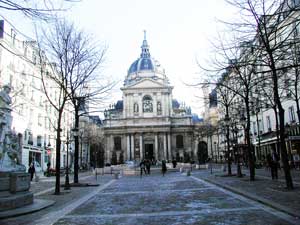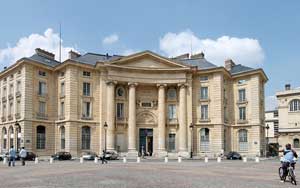
Cramped, cobbled and filled with students speaking Latin, the streets of the Latin Quarter were never the same again after the founding of the Sorbonne in 1257.
Robert de Sorbon, confessor of Louis IX (Saint Louis), decided to create a college for impoverished theology students in Paris and with the support of the Pope, the Sorbonne was born.
Since 1257, the Sorbonne has diversified its curriculum somewhat and has established itself amongst the world's leading universities. Soon after its founding, it became a base for the University of Paris and France's first printing house was opened here in 1470.
Historically student-riddled, the Latin Quarter has grown up partly in the shadow of the Sorbonne. The prestigious dome that crowns the chapel is ever-visible and the actions of the students have always been at the forefront of French history.
It is 3rd May 1968 and indignation and anger fill the streets of the Latin Quarter.
Nanterre University has been closed down by the administration after a months-long dispute between staff and students. At the Sorbonne students crowd into the courtyard protesting against the closure of Nanterre. Violence erupts as police attempt to clear the courtyard and everything breaks down into chaos: that evening 100 people were injured and 596 arrested.
And so began what would come to be known simply as Mai 1968.

In the following days, the anger and chaos escalates. The pressure builds like a volcano and finally Monday 6th May explodes into 5 hours of rioting in the center of Paris.
So the Latin Quarters is the background where over 20,000 people -- students followed by teachers and supporters -- march in protest. The university is still sealed off by police, who charge wielding batons and tear gas at the first sign of the protesters.
Panic ensues and while the crowd disperses, some people begin to make barricades out of anything they can find to force the police to retreat. The rudimentary defense works at first but the police soon overpowers the barricades and the crowds flee. 422 people were arrested while 345 police and 600 students were injured.
The night of 10th May sees the pinnacle of the conflict. Once again huge crowds gathered on the Left Bank. The riot police stopped the crowd from crossing the river so the mob again created barricades. Negotiations ensued but stalled and so the police attacked at 2:15 in the morning.
The confrontation lasted until dawn of the following day and countless people were arrested and injured.
The events were broadcast on radio as they occurred and the aftermath was shown on television the following day. Some people alleged that the police themselves were to blame for the escalation in events.
The government's excesses led two thirds of the French workforce to go on strike.
France was practically paralyzed - there were no newspapers, no 20.00 news on TV, no public transport. On 27th May an agreement is reached between the unions and the government: they are to raise the minimum wage, cut working hours, reduce the age of retirement and maintain the right to organize themselves protected.
In April 1969 the results of a referendum see 12,007,102 people vote non when asked if de Gaulle should continue as President of France. In June Georges Pompidou is elected President of the Republic.